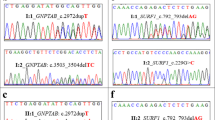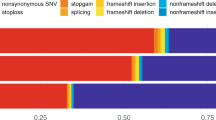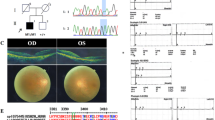Abstract
Basan syndrome is a rare autosomal dominant genodermatosis, characterized by rapidly healing congenital acral bullae, congenital milia and lack of fingerprints. A mutation in the SMARCAD1 gene was recently reported to cause Basan syndrome in one family. Here, we present a large Chinese family with Basan syndrome; some patients presented with hyperpigmentation and knuckle pads in addition to previously reported clinical manifestations. We used genome-wide linkage analysis and whole-genome sequencing (WGS) to identify the pathogenic gene in this unique pedigree. Genome-wide linkage analysis successfully mapped the candidate gene to 4p15.31-4p14 and 4q13.2-4q23. The maximal LOD score was 3.01. WGS in one patient identified a splice variant (c.378+1G>T) in the SMARCAD1 gene (NG_031945.1) that was confirmed by Sanger sequencing. Co-segregation of the variant was confirmed in this pedigree. The same variant was recently found to be associated with isolated adermatoglyphia (ADG) in another family, suggesting that this variant is causative for both Basan syndrome and autosomal dominant ADG (OMIM 136 000). This indicates that ADG and Basan syndrome may be the phenotypic variants of the same disease. Further studies should be performed to elucidate the pathogenic mechanisms induced by this variant. This report increases the phenotypic spectrum of Basan syndrome and furthers our understanding of the genetic basis of this disease. Our results also highlight the power of combining WGS and genome-wide linkage analysis in identifying causative genes in pedigrees with a genetic disorder.
Similar content being viewed by others
Log in or create a free account to read this content
Gain free access to this article, as well as selected content from this journal and more on nature.com
or
References
Basan M : Ectodermal dysplasia. Missing papillary pattern, nail disorders and furrows on 4 fingers. Arch Klin Exp Dermatol 1965; 222: 546–557.
Gagey-Caron V, Stalder JF, Barbarot S : Basan's syndrome: Congenital absence of dermatoglyphs and milia. Ann Dermatol Venereol 2009; 136: 419–421.
Burger B, Fuchs D, Sprecher E, Itin P : The immigration delay disease: adermatoglyphia-inherited absence of epidermal ridges. J Am Acad Dermatol 2011; 64: 974–980.
Baird HW 3rd : Kindred showing congenital absence of the dermal ridges (fingerprints) and associated anomalies. J Pediatr 1964; 64: 621–631.
Límová M, Blacker KL, LeBoit PE : Congenital absence of dermatoglyphs. J Am Acad Dermatol 1993; 29: 355–358.
Luna PC, Larralde M : Profuse congenital familial milia with absent dermatoglyphics (Basan's syndrome): description of a new family. Pediatr Dermatol 2012; 29: 527–529.
Reed T, Schreiner RL : Absence of dermal ridge patterns: genetic heterogeneity. Am J Med Genet 1983; 16: 81–88.
Rutter KJ, Judge MR : Profuse congenital milia in a family. Pediatr Dermatol 2009; 26: 62–64.
Rowbotham SP, Barki L, Neves-Costa A et al: Maintenance of silent chromatin through replication requires SWI/SNF-like chromatin remodeler SMARCAD1. Mol Cell 2011; 42: 285–296.
Marks KC, Banks WR 3rd, Cunningham D, Witman PM, Herman GE : Analysis of two candidate genes for Basan syndrome. Am J Med Genet A 2014; 164A: 1188–1191.
Nousbeck J, Sarig O, Magal L et al: Mutations in SMARCAD1 cause autosomal dominant adermatoglyphia and perturb the expression of epidermal differentiation-associated genes. Br J Dermatol 2014; 171: 1521–1524.
Nousbeck J, Burger B, Fuchs-Telem D et al: A mutation in a skin-specific isoform of SMARCAD1 causes autosomal-dominant adermatoglyphia. Am J Hum Genet 2011; 89: 302–307.
Lugassy J, Itin P, Ishida-Yamamoto A et al: Naegeli-Franceschetti-Jadassohn syndrome and dermatopathia pigmentosa reticularis: two allelic ectodermal dysplasias caused by dominant mutations in KRT14. Am J Hum Genet 2006; 79: 724–730.
Heimer WL 2nd, Brauner G, James WD : Dermatopathia pigmentosa reticularis: a report of a family demonstrating autosomal dominant inheritance. J Am Acad Dermatol 1992; 26: 298–301.
van Steensel MA, Lemmink HH : A missense mutation in KRT14 causing a dermatopathia pigmentosa reticularis/Naegeli-Franceschetti-Jadassohn phenotype. J Eur Acad Dermatol Venereol 2010; 24: 1116–1117.
Acknowledgements
We thank all subjects for their ongoing participation in this study. This work was supported by a grant from the National Nature Science Foundation of China (81472867) and a grant from the Research Fund for the Doctoral Program of Higher Education (20130073120014).
Author information
Authors and Affiliations
Corresponding authors
Ethics declarations
Competing interests
The authors declare no conflict of interest.
Additional information
Supplementary Information accompanies this paper on European Journal of Human Genetics website
Rights and permissions
About this article
Cite this article
Li, M., Wang, J., Li, Z. et al. Genome-wide linkage analysis and whole-genome sequencing identify a recurrent SMARCAD1 variant in a unique Chinese family with Basan syndrome. Eur J Hum Genet 24, 1367–1370 (2016). https://doi.org/10.1038/ejhg.2016.15
Received:
Revised:
Accepted:
Published:
Issue date:
DOI: https://doi.org/10.1038/ejhg.2016.15



